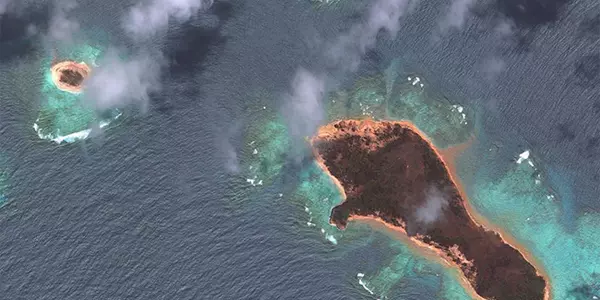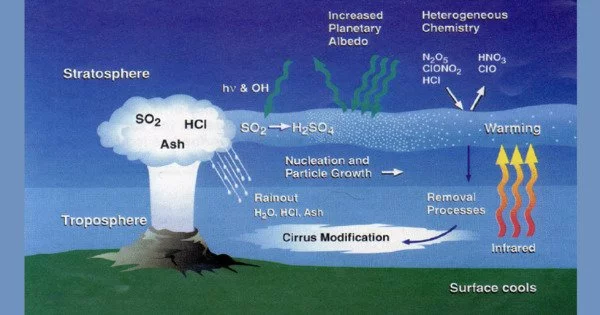Volcanoes can have an impact on climate change. Massive amounts of volcanic gas, aerosol droplets, and ash are injected into the stratosphere during major explosive eruptions. Injected ash falls rapidly from the stratosphere, with most of it being removed within days to weeks, and has little effect on climate change. However, volcanic gases such as sulfur dioxide have the potential to cause global cooling, whereas volcanic carbon dioxide, a greenhouse gas, has the potential to promote global warming.
The January eruption of the Hunga Tonga-Hunga Ha’apai volcano gave scientists a once-in-a-lifetime opportunity to study how the atmosphere works, unlocking keys to better predict the weather and changing climate.
The volcano, located in the South Pacific nation of Tonga, became active Dec. 20, 2021, and erupted Jan. 15, 2022. The blast obliterated one of the country’s many islands and was described by NASA as more powerful than an atomic bomb.
Mathew Barlow, professor of environmental, earth, and atmospheric sciences at UMass Lowell, was part of an international team of scientists who studied the unprecedented atmospheric response to the eruption. Nature published the group’s findings.
Some of the wave types generated by the Hunga Tonga are very important to understanding how the atmosphere works and our ability to make effective computer models for weather forecasting and climate projections.
Mathew Barlow
As part of his work, Barlow created an animated video using satellite data that depicts the dramatic effects of the eruption. The event saw atmospheric waves pulse around the globe several times and stretch from Earth to the edge of space, reaching speeds of up to 720 miles per hour in some places. The eruption also sent a plume of water vapor, volcanic ash, soil, and smoke 31 miles into the atmosphere. The effects are summarized in a short video created by the researchers.
The main effect on weather right near a volcano is that there is often a lot of rain, lightning, and thunder during an eruption. This is because all the ash particles that are thrown up into the atmosphere are good at attracting/collecting water droplets. We don’t quite know exactly how lightning is caused but it probably involves the particles moving through the air and separating positively and negatively charged particles.

The most significant climate impacts from volcanic injections into the stratosphere come from the conversion of sulfur dioxide to sulfuric acid, which condenses rapidly in the stratosphere to form fine sulfate aerosols. The aerosols increase the reflection of radiation from the Sun back into space, cooling the Earth’s lower atmosphere or troposphere.
“Some of the wave types generated by the Hunga Tonga are very important to understanding how the atmosphere works and our ability to make effective computer models for weather forecasting and climate projections,” said Barlow, a climate change initiative faculty member at UMass Lowell. “Some strong eruptions can also have a cooling effect on the climate through the expulsion of particles into the high atmosphere, though the amount produced by Hunga Tonga does not appear to be sufficient for a notable climate effect, unlike other volcanic eruptions over the last century, such as the Pinatubo eruption in Alaska in 1991.”
According to Barlow, the Hunga Tonga eruption appears to be the most powerful single burst of volcanic energy released in 140 years, since the Krakatoa volcano in Indonesia erupted in 1883. The strength of the Hunga Tonga eruption, combined with advances in satellite imagery, provided scientists with an unprecedented view of atmospheric waves. According to Barlow, he and his colleagues were able to analyze its effects in near-real time communication with agencies all over the world.
There is no doubt that large volcanic eruptions can release significant amounts of CO2 into the atmosphere. Mount St. Helens’ 1980 eruption released approximately 10 million tons of CO2 into the atmosphere in only 9 hours. However, it now only takes humanity 2.5 hours to produce the same amount. While large explosive eruptions like this are rare, occurring only every 10 years or so on average, humanity’s emissions are constant and increasing year after year.
There are ongoing efforts to reduce uncertainties and improve estimates of current-day global volcanic CO2 emissions, but volcanic gas scientists are unanimous in their belief that anthropogenic CO2 emissions dwarf global volcanic CO2 emissions.





